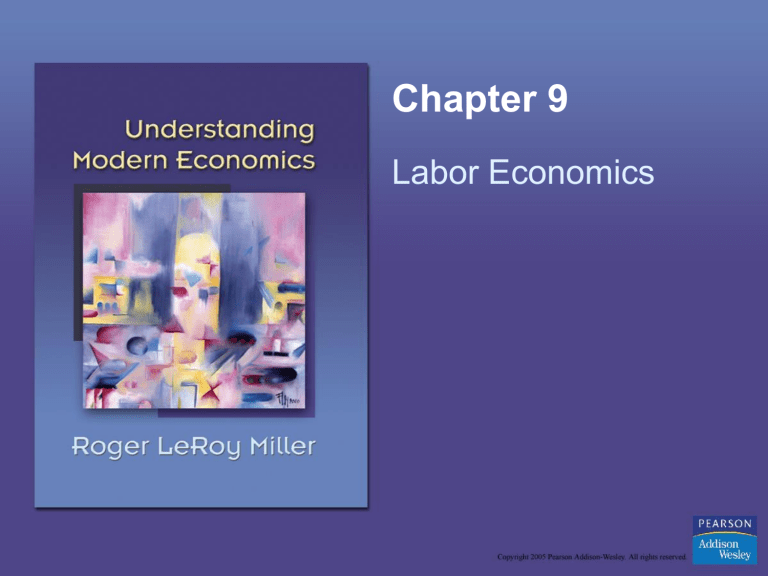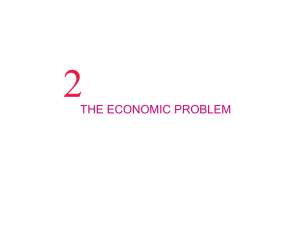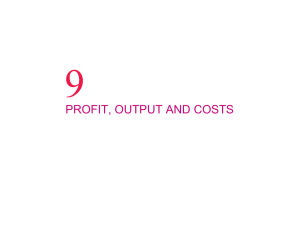
Chapter 9
Labor Economics
Learning Objectives
• Determine why the demand curve for labor slopes
downward.
• List some of the reasons why the demand curve for
labor will shift and why the supply curve for labor
will shift.
• Explain why raising the federal minimum wage
typically leads to higher unemployment among
unskilled workers.
• State one of the major roles of a labor union.
• Describe the determinants of the differences in
income.
Copyright © 2005 Pearson Addison-Wesley. All rights reserved.
9-2
What Determines the Total
Supply of Labor?
• Numerous factors enter into your
decision about how many hours to work
in a particular job.
• The single most important determinant
of your quantity of labor supplied is how
much you are paid.
Copyright © 2005 Pearson Addison-Wesley. All rights reserved.
9-3
Figure 9-1: The Supply of Labor
Curve for One Individual
Copyright © 2005 Pearson Addison-Wesley. All rights reserved.
9-4
Supply of Labor
• Because the cost of leisure is its opportunity
cost, the higher the after-tax wage rate, the
larger the quantity of labor supplied. This is
called the substitution effect.
• As after-tax raises increase, eventually
workers become so rich they want to buy
more of everything, including leisure, so that
the quantity supplied of labor actually starts to
fall. This is called the income effect.
Copyright © 2005 Pearson Addison-Wesley. All rights reserved.
9-5
The Demand for Labor
• The demand for labor is a derived
demand, derived from the demand
for a final good or service.
• All other things held constant, the
greater the demand for the final good or
service being produced, the greater the
demand for workers.
Copyright © 2005 Pearson Addison-Wesley. All rights reserved.
9-6
The Demand for Labor (cont.)
• The two factors that determine the
value of a worker to an employer are:
1. how much product a worker can produce
in a given time period, and
2. how much each unit of that product is
worth.
Copyright © 2005 Pearson Addison-Wesley. All rights reserved.
9-7
Marginal Physical Product
• The marginal physical product (MPP)
of labor is the change in output
resulting from employing one more
worker, holding all other factors of
production constant.
• The law of diminishing marginal returns
predicts that additional units of labor
will, after some point, cause the MPP
to decline, other things held constant.
Copyright © 2005 Pearson Addison-Wesley. All rights reserved.
9-8
Marginal Revenue Product
• Marginal revenue product (MPR)
represents the incremental worker’s
contribution to the firm’s total revenues.
• We calculate the MPR by multiplying
the marginal physical product by the
marginal revenue of the firm. This
translates the physical product that
results from hiring an additional worker
into a dollar value.
Copyright © 2005 Pearson Addison-Wesley. All rights reserved.
9-9
Marginal Factor Cost
• The marginal cost of workers is the
extra cost incurred in employing an
additional unit of that factor of
production. We call that cost the
marginal factor cost (MFC).
Change in total cost
Marginal factor cost =
Change in amount of resource used
Copyright © 2005 Pearson Addison-Wesley. All rights reserved.
9-10
General Rule for Hiring
• The firm hires workers up to the point at
which the additional cost associated
with hiring the last worker is equal to the
additional revenue generated by the
worker.
• In a perfectly competitive market, this is
the point at which the wage rate equals
the marginal revenue product (MRP).
Copyright © 2005 Pearson Addison-Wesley. All rights reserved.
9-11
Equilibrium
• Equilibrium for the firm is obtained
when the firm’s demand curve for labor,
which turns out to be its MRP curve,
intersects the firm’s supply curve for
labor, shown as s in Figure 9-2, next.
Copyright © 2005 Pearson Addison-Wesley. All rights reserved.
9-12
Figure 9-2: Equilibrium
Copyright © 2005 Pearson Addison-Wesley. All rights reserved.
9-13
Reasons for Labor Demand
Curve Shifts
• Because the demand for labor or any
other variable input is a derived
demand, the labor demand curve will
shift if there is a shift in the demand
for the final product.
• A change in the demand for the final
product that labor is producing will shift
the market demand curve for labor in
the same direction.
Copyright © 2005 Pearson Addison-Wesley. All rights reserved.
9-14
Reasons for Labor Demand
Curve Shifts (cont.)
• A change in labor productivity will
shift the market labor demand curve in
the same direction.
• A change in the price of a substitute
input will cause the demand for labor to
change in the same direction.
Copyright © 2005 Pearson Addison-Wesley. All rights reserved.
9-15
Reasons for Labor Demand
Curve Shifts (cont.)
• A change in the price of a
complementary input will cause the
demand for labor to change in the
opposite direction.
Copyright © 2005 Pearson Addison-Wesley. All rights reserved.
9-16
Determinants of the Industry
Supply of Labor
• Changes in wages rates across
industries.
• Changes in working conditions in
an industry can also affect its labor
supply curve.
• Job flexibility may also determine the
position of the labor supply curve.
Copyright © 2005 Pearson Addison-Wesley. All rights reserved.
9-17
The Minimum Wage
• Not all labor markets are unrestricted.
Nationwide, there is a federal minimum
wage, which is the lowest legal hourly
wage rate that may be paid to certain
types of workers.
• The federal minimum wage started at
25 cents per hour in 1938. At that time,
25 cents represented 40 percent of the
average manufacturing wage.
Copyright © 2005 Pearson Addison-Wesley. All rights reserved.
9-18
Effects on the Quantity of Labor
Supplied and Demanded
• The higher the federal minimum wage,
the greater the quantity of unskilled
labor supplied.
• At higher federal minimum wages, a
lower quantity of unskilled labor will be
demanded.
Copyright © 2005 Pearson Addison-Wesley. All rights reserved.
9-19
The Result: A Surplus of Workers
at the Minimum Wage Rate
• If the federal government sets the
minimum wage rate above the
equilibrium wage rate, the inevitable will
result: A surplus of workers at that
relatively high wage rate.
• This surplus of workers represents
higher unemployment.
Copyright © 2005 Pearson Addison-Wesley. All rights reserved.
9-20
Figure 9-4: The Results of Setting the
Minimum Wage above the Market
Clearing Wage Rate
Copyright © 2005 Pearson Addison-Wesley. All rights reserved.
9-21
Organized Labor
• Labor unions usually help their
members if in some way they can
restrict supply in order to obtain higherthan-competitive wage rates and
benefits—working conditions,
job security, health insurance—for their
members.
Copyright © 2005 Pearson Addison-Wesley. All rights reserved.
9-22
The American Labor Movement
• In the 1800s, workers began to form
unions in an attempt to force employers
to improve wages and working
conditions.
• For much of its history, organized labor
in this country has been split into two
groups: craft unions and industrial
unions.
Copyright © 2005 Pearson Addison-Wesley. All rights reserved.
9-23
The American Labor Movement
(cont.)
• A craft union is made up of workers in
a specific trade like bricklaying.
• An industrial union is made up of
all of the workers in an industry
regardless of job or level of skills.
Copyright © 2005 Pearson Addison-Wesley. All rights reserved.
9-24
Collective Bargaining
• Collective bargaining is the process by
which unions and its employers negotiate the
conditions of employment and wages. At the
center of the collective bargaining process is
a compromise.
• Employers desire to keep wages and benefits
low in order to have lower labor costs and
therefore remain competitive. Labor unions
wish to increase wages and benefits for their
workers.
Copyright © 2005 Pearson Addison-Wesley. All rights reserved.
9-25
Strikes
• Most collective bargaining negotiations are
successful. When negotiations breakdown, a
strike—deliberate work stoppage by
workers—results.
• Striking unions may use a boycott to exert
more economic pressure against firms in an
industry. In a boycott, unions urge the public
not to purchase goods or services produced
by the company it is striking.
Copyright © 2005 Pearson Addison-Wesley. All rights reserved.
9-26
The Goals of the Union
• One of the major roles of a union that
succeeds in establishing a wage rate
above the market clearing wage rate is
to ration available jobs among the
surplus of workers who wish to work in
unionized industries.
Copyright © 2005 Pearson Addison-Wesley. All rights reserved.
9-27
Income Distribution
• Workers can each expect to be paid
their marginal revenue product. This
means that, if they increase their
marginal physical product, they can
expect to be paid more.
• Some of the determinants of marginal
physical product are: talent,
experience and training.
Copyright © 2005 Pearson Addison-Wesley. All rights reserved.
9-28
Income Distribution
• Investment in human capital—
education—pays off, for each additional
degree earned results in a markedly
higher average income.
• Inheritance and discrimination may
affect income differences, although
inheritance accounts for only 10 percent
of income inequality in the United
States.
Copyright © 2005 Pearson Addison-Wesley. All rights reserved.
9-29
Key Terms and Concepts
• boycott
• collective bargaining
• craft union
• derived demand
• income distribution
• income effect
• industrial union
• labor productivity
• labor unions
Copyright © 2005 Pearson Addison-Wesley. All rights reserved.
• marginal factor cost
(MFC)
• marginal physical
product (MPP) of Labor
• marginal revenue
product (MRP)
• minimum wage
• strike
• substitution effect
9-30








